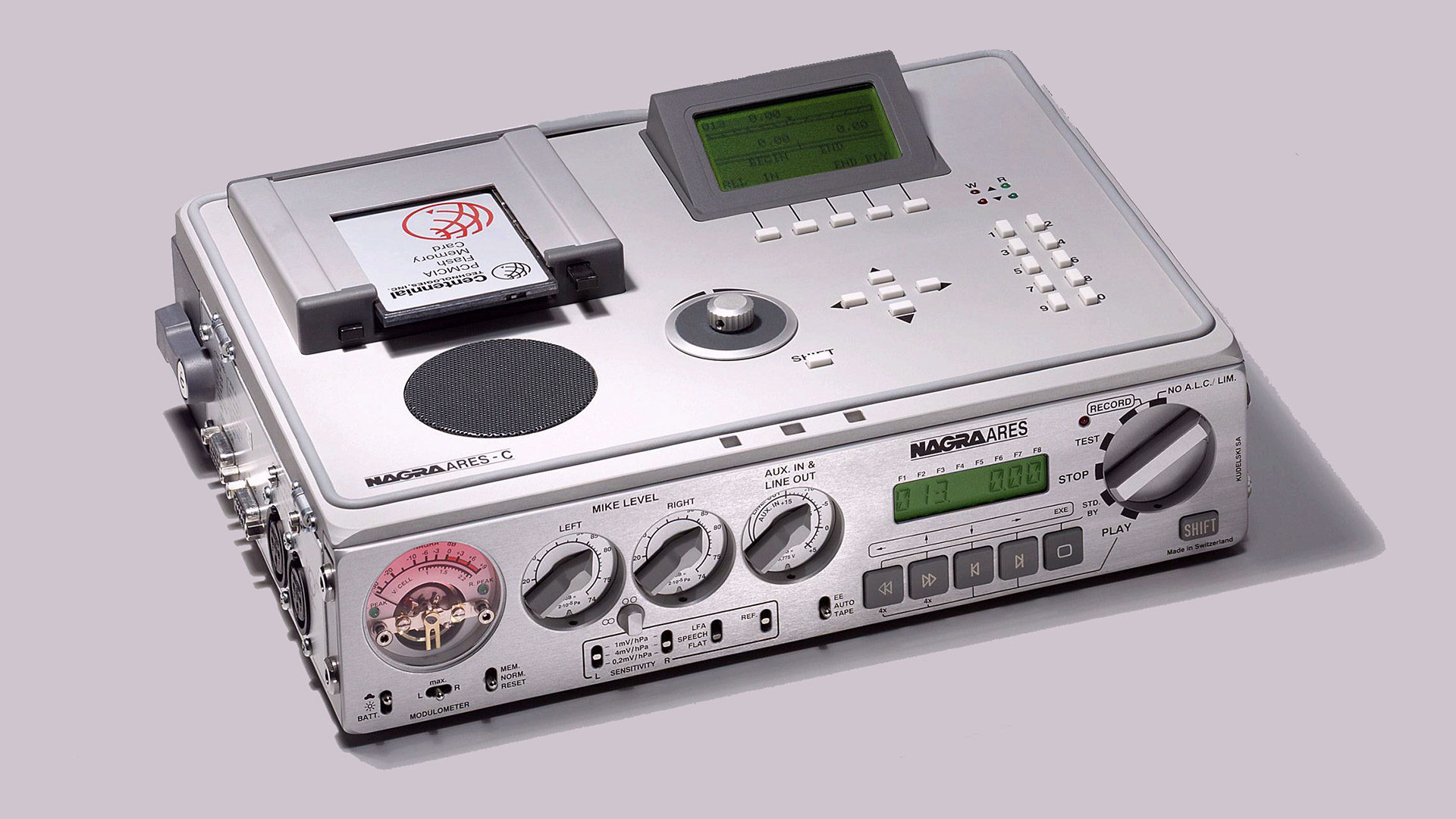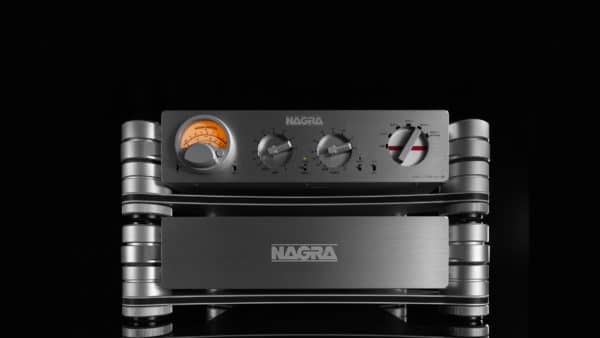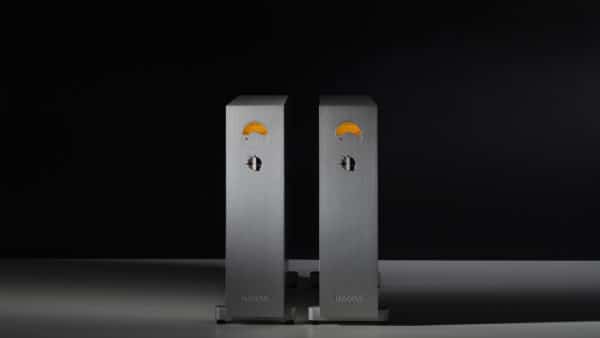Manufactured from 1995 to 2007
16-bit solid state audio recorder/player
The ARES-C is a 16-bit solid state audio recorder/player using PC FLASH Memory Cards (PCMCIA) or compact flash as its storage medium.
The information is stored using the MPEG-2 (Mono or Stereo), G722, u-law, A-law compression standards and can be optionally equipped with either an on-board ISDN CODEC allowing direct connection to the ISDN network, or a fully featured SMPTE/EBU time code system. Recorded material can be internally edited and copied between cards with an easy to use, non-destructive editor which is a standard feature. Weighing less than 6 1/2 lbs., the ARES-C packs a powerhouse of features into a small package. With no moving parts, this solid state recorder is impervious to shock and vibration. And with all these advantages, it is still a NAGRA with proven reliability even in the harshest environmental extremes.
Key features
The front panel, metal chassis, and features of the ARES-C were all designed using the experience of previous NAGRA recorders. This renders the ARES-C easy to operate and assures performance in temperatures from -5 degrees to +140 degrees Fahrenheit. It is powered by standard “D” cells, available worldwide, or rechargeable Ni-Cd sticks or a Lithium-Ion pack. Continuous operation is assured with the available AC charger, Still, more than 8 hours of operation can be obtained from batteries alone. Equipped with switchable +48V phantom powered microphone pre-amplifiers, built-in monitoring speaker and headphone amplifier and programmable Automatic Level Control, the ARES-C bears a resemblance to its NAGRA predecessors.
Two auxiliary inputs, which can be mixed together with microphone inputs, as well as an input for signals treated with external noise reduction are available through the EXTENSION connection. Also available on this connector is the input for external clock sources. Two balanced line level outputs, one AES digital output and even a 600 ohm transformer coupled bi-directional telephone connection are standard on the ARES-C.
Designed as an over-the-shoulder recorder, all control and monitoring of input and output levels, operating modes and even menu function programming is available from the front panel. A set of software menus allows a simple configuration of the machine for all modes of operation providing flexibility to adapt to any situation. Four templates are available to store and instantly recall setups making field operation simple for even occasional users.
RECORDER
– The ARES-C uses 16 bit sigma-delta AD/DA conversion to digital data which is stored on either of two available PC FLASH Ram cards. This dual card approach provides for a seamless transition from card to card during recording for essentially unlimited recording time. Files can be copied between cards at high speed via the special copy function. Sampling frequencies are selectable from 16, 24, 32 or 48 kHz. Data compression rates are selectable between 64, 128 and 192 kbs using G711, G722 or broadcast quality MPEG II providing full 20 kHz bandwidth even in MPEG stereo. Individual card sizes are currently available up to 192 Mbytes providing over 3.15 hours of Stereo recording time. This indestructible media can be re-recorded up to 100,000 times. Automatic take list generation and file management is stored in the card’s directory which allows random access playback of selected cuts. All information recording the takes is displayed in the directory for easy identification. You even have the ability to give each one a title.
EDITOR
– Non-destructive digital editing is performed in a quick cut and paste method. The scrub wheel allows for precise location of editing IN and OUT points to within 24 milliseconds. Edits are compiled by sequencing head to tail edits as well as insertion of material from one take into another take. Removal of edit points (UNDO) and complete sections between markers is possible with delete function. Source material can be added to or deleted from an edit by the jog wheel. In this way, edits can be moved easily. Various edits of the same material can be stored even on a fully recorded card and are indicated as such in the directory. Each edit can be given a title as well.
INTERNAL ISDN OPTION
– With the universal ISDN option, files may be transmitted from the ARES-C in the field directly to the studio in the digital domain. A studio version of the ARES-C, the C-PP, is available with all the same features as the ARES-C. Direct downloading via the ISDN network can be performed from the field ARES-C to the studio C-PP. Delayed transmission is possible with the auto-answer/auto-record feature which allows unattended record or playback. Live two-way remote communications are possible using the recorder’s universal mic and line inputs. This option provides for a simultaneous mix of mic and line inputs for the outgoing signal, as well as mixing the return from a remote ARES-C. The C-PP unit lends itself effectively for voice over applications requiring recording and editing of various takes of the same material. The result can be transmitted in the digital domain to the destination studio. This option provides the following features:
- US National 1 / EURO ISDN auto detection
- Industry-wide ISDN CODEC compatibility
- Unattended auto-answer and auto-record
- Loss-less digital file transmission
- Stores frequently dialed numbers
- Data-mode and Voice-mode connections
- On-air, two-way “live remote” capability
- Mix live inputs with recorded or edited takes
- Broadcast quality audio via dial-up connection
INTERNAL TIME CODE OPTION
– The SMPTE/EBU 80-bit format meets all existing professional time code standards. The time code in and out points appear on the standard Nagra 5-pin LEMO connector. External reference signals are connected to the machine via the BNC connector allowing it to lock it’s internal reference to outside WORDCLOCK, SPDIF or VIDEO clocks. This option provides the following features:
- Accommodates all current frame-rate standards
- Internal time code generator
- Two internal time code readers
- Instant chase-lock synchronization
- Synchronize mixed frame-rate standards
- Free, Date, Auto-increment User-bit modes
- Record Run and seamless Assemble modes
- Synchronize Master Clock to external video, word-clock, or SPDIF
- Internal Master Clock +0.1% mode
- “Pull-up, pull-down” to video reference
- VCLO for locking to out-of-range references
Software for the NAGRA Series C Recorders ARES 95 / NT
In a continuing effort to provide audio professionals with innovative tools with which to store and distribute sound, Nagra now presents ARES 95/NT. As a pioneer in recording audio to FLASH RAM, PCMCIA technology, Nagra developed a way to overcome the limitations of the FLASH RAM media for archival and distribution of stored digital data.
In a joint effort, Nagra-Kudelski collaborated with Numisys in France to create a software program that would permit the transfer of recorded files, along with the information found in the Directory, directly into a PC or laptop equipped with a PCMCIA slot. This made possible the erasure and reuse of the FLASH memory card for further recordings.
Original recordings on the Series-C machines are stored as RAW files. Along with the digital audio, information for each “take” such as time and date of the recording, the compression algorithm and sampling frequency used to make the recording, start time code address and user bits (if equipped with the SMPTE option), and even a title or text (31 characters) are stored in the Directory of the FLASH card.
This information is also transferred across to be stored in the computer. Individual takes, selected takes or the entire contents of the Flash card can be transferred. Once on the hard drive, these files can then be played back through applications such as Windows Media Player.
Along with the capacity to store these audio files, ARES 95/NT also provides the ability to convert them into different forms during the transfer process. Originally, recorded files are stored as RAW files. These RAW files can be converted to Broadcast WAV, preserving the start time code information. The compressed bit-rate of the data can be changed or even be converted to PCM (linear) audio. The sampling frequency can be changed to any of three possibilities, 32 kHz, 44.1 kHz or 48 kHz. Also, files can be converted to / from mono, stereo, joint stereo or dual mono.
Nagra engineers are currently working with other manufacturers of digital editing systems to provide direct data transfer of Series-C recorded files. Manufacturers such as SADiE, Dalet, David and Netia already enjoy direct importation. Through conversion to linear Broadcast WAV, direct importation of digital files from the Series-C are possible with others as well.
User Manuals : Français / English ISDN / English Time Code
Other products to discover
Get the latest news from Nagra plus some exclusive content directly in your inbox.


